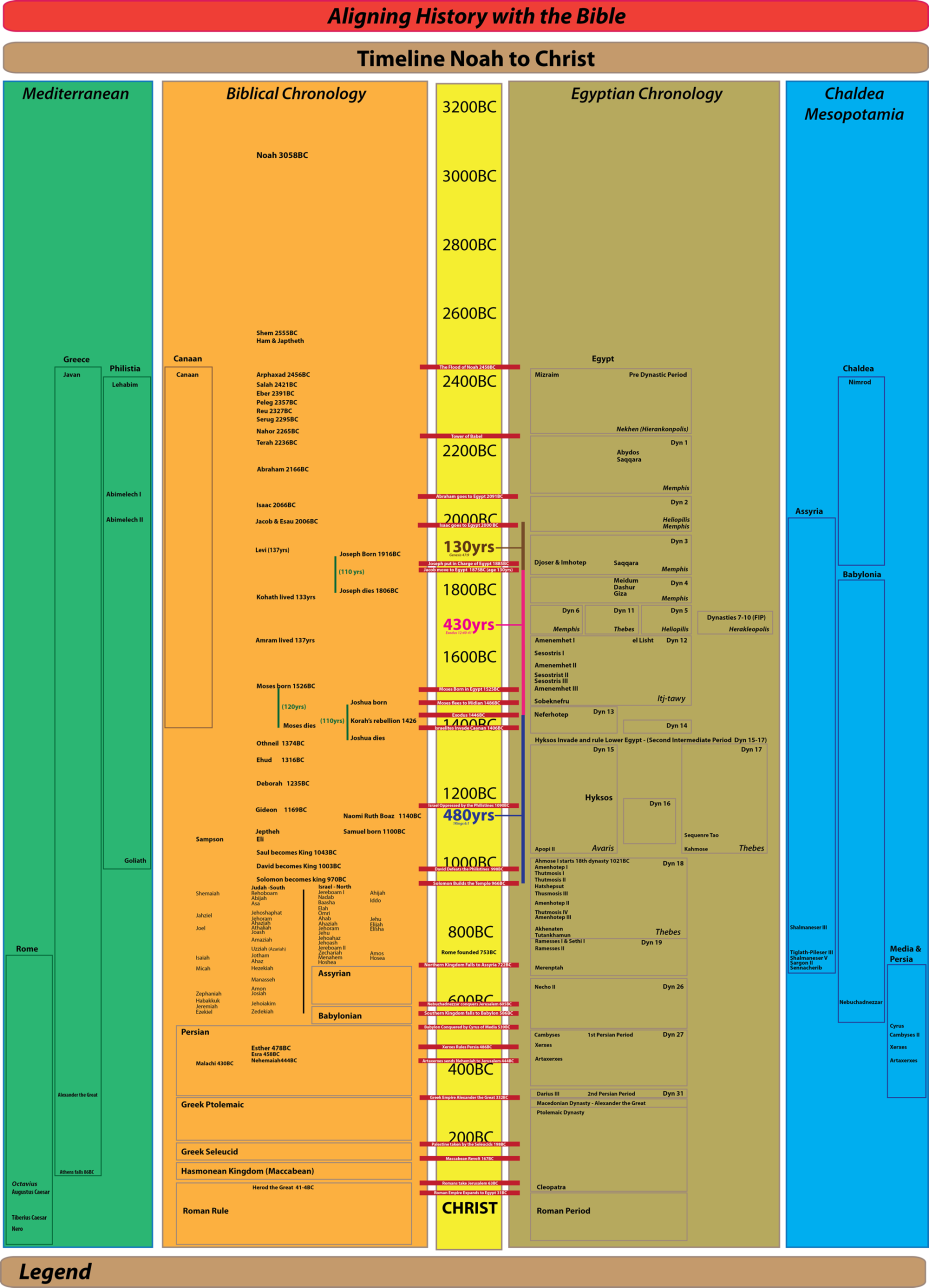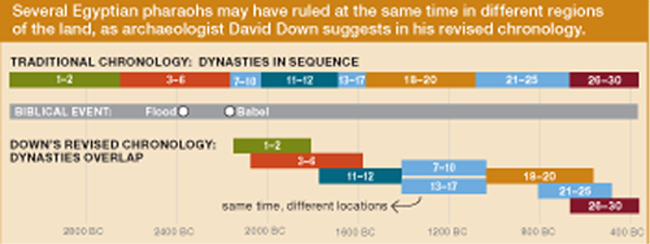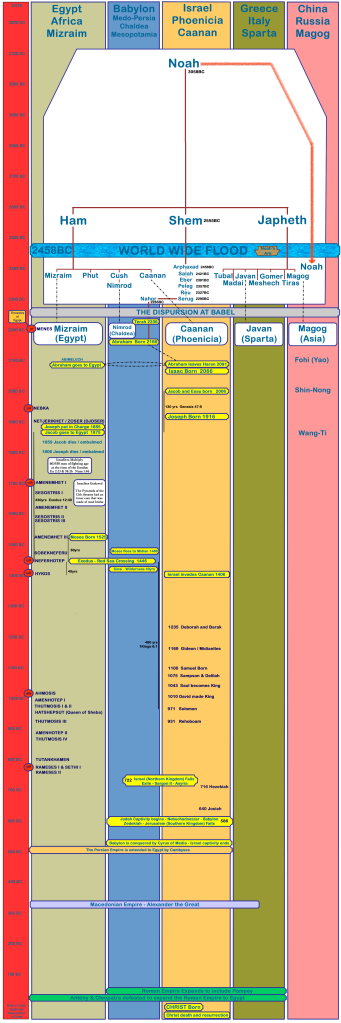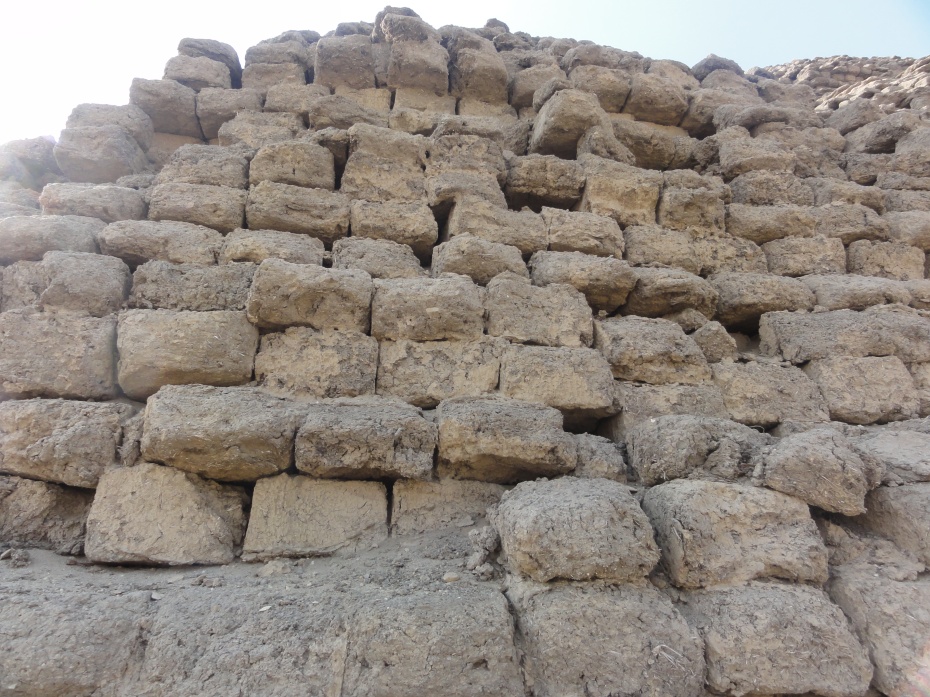Posts Tagged With: Sojourn
History aligned with the Bible
David Down’s revised Egyptian Chronology places Moses in the 12th dynasty. With a long sojourn and no first intermediate period, his chronology fits with Joseph being Imhotep.
Did the Israelite Sojourn in Egypt last 400 Years or 430 years?
It was foretold to Abraham in a dream that his descendants would serve as slaves in a foreign land for 400 yrs (or 4 generations of priests). Genesis 15:12-16
Yet the Bible also tells us that the Israelites lived in Egypt for 430 years to the very day. Exodus 12:40-41
The Israelite Oppression ended when the 12th dynasty ended, about 10 years after Moses / Amenemhet IV went into exile at the age of 40 years. This was 400 years after Jacob and his family came to Egypt. The Exodus did not take place until 30 years into the 13th dynasty when Moses / Amenemhet IV returned to confront Neferhotep I at the age of 80 years.
The Israelite oppression lasted 400 years – it ended when the 12th dynasty ended. No more pyramids were built after the 12th dynasty. The 13th dynasty was very chaotic and the Pharaohs did not focus on oppressing the Israelites because their thrones were not stable enough and maybe their attitude towards the Israelites was slightly more sympathetic than that of the 12th dynasty pharaohs. The Exodus occurred 30 years into the 13th dynasty during the reign of Neferhotep I who was the longest ruling pharaoh of that dynasty (11 years).
Amenemhet III would have reigned between 2-6 years after Moses fled to Midian and Sobekneferu would have reigned between 4-8 years after her father Amenemhet III and then she died. When she died, the 12th dynasty ended as there was no heir to the throne. The result was that Egypt fell into Chaos. There was a rapid succession of Pharaohs in the 13th dynasty and as a result, the Israelites were not oppressed during this time. They were able to keep multiplying and prepare to leave Egypt.
The Exodus occurred exactly 40 years after Moses fled to Midian and about 30 years after the 12th dynasty ended with the death of Sobeknefru.
The Pharaoh when Moses was Born (Amenemhet III)
The Pharaoh when Moses was Born
Moses/Amenemhet IV was 80 years old when he lead the Israelites out of Egypt in 1446BC. The Israelites were in Egypt for 430 years. Moses was born 80 years before the Exodus in 1526BC. The Israelites, therefore, had been in Egypt for 350 years when Moses was born. Joseph/Imhotep was long since dead and by the time of the Exodus the Israelites numbered around 2 million as there were over 600,000 men of fighting age.
The Israelites flourished and multiplied quickly when they first came to Egypt in the 3rd dynasty when Djoser (Netjerikhet) was pharaoh. They had the blessing of the Pharaoh and they enjoyed the protection of the vizier Joseph/Imhotep while he was alive. They lived in Goshen, the most fertile part of Egypt.
At the end of the 6th and 11th dynasty (which ran contemporaneously in different parts of the country), there was an uprising by Amenemhet I who was the vizier for Mentuhotep IV of the 11th dynasty. He assassinated Mentuhotep IV and became the first pharaoh of the 12th dynasty, eventually taking over all of upper and lower Egypt. Amenemhet I did not care or remember that the Israelites were related to Joseph/Imhotep who had saved Egypt from a seven year famine and made the pharaohs rich. This pharaoh (Amenemhet I) ruthlessly forced the Israelites to work the fields and make mud bricks for his public works. The 12th dynasty pyramids were composed largely of mud bricks which were then covered or faced with a limestone veneer. (Some of the inner rooms and passage ways were also made of limestone.)
The 12th dynasty spanned almost 200 years. Amenemhet III was the sixth pharaoh of this dynasty and he built two pyramids. He reigned for 46 years. He co-reigned with his father Sesostris III for as long as 20 years at the beginning of his reign. At the end of his reign, he co-reigned with his intended successor Amenemhet IV for 9 years but was succeeded by his daughter Sobeknefru because Amenemhet IV suddenly disappeared. Sobeknefru only lived for another 4-8 years and then the 12th dynasty ended and Egypt was thrown into turmoil. There was a rapid succession of pharaoh’s in the next dynasty and no pyramids were constructed during this time. Towards the end of the 13th dynasty, which lasted less than 40 years, there was a sudden exodus of slaves from Egypt. This occurred during the reign of Neferhotep. Kahun, for example, was a slave village that was occupied from the time of Sesostris II up until the time of Neferhotep, as evidenced by the scarabs that Flinders Petrie found in the town. Petrie also found evidence that the town was suddenly vacated.
Moses spent the first 40 years of his life growing up in Pharaoh’s household. The pharaoh’s daughter, being childless, adopted Moses (a Hebrew baby who she found hidden amongst the reeds of the Nile) and raised him as her own. She would have groomed Moses to be the next heir to the throne.
There was no change of pharaohs during Moses’s first 40 years. The pharaoh of the time would have reigned at least 40 years.
Moses lead the Israelites out of Egypt at the age of 80 years, 40 years after Moses went into Exile.
Egypt was devastated by the Exodus. With the loss of it’s slaves, Egypt was no longer able to construct pyramids. With the loss of it’s army, Egypt was no longer able to defend itself. Egypt was invaded by the Hyksos not long after the Exodus.
It is highly likely that Amenemhet III was the Pharaoh that was reigning when Moses was born. He reigned for 46 yrs and would have seen Moses reach the age of 40 years. Amenemhet III had a daughter (Sobeknefru) who was childless. Amenemhet III was the last of a long line of pharaohs in the 12th dynasty who needed a large slave labour force to construct the massive pyramids of the 12th dynasty that were composed chiefly of mud bricks reinforced with straw.
The Hebrews were numerous enough and living in Egypt long enough to have made the mud bricks for all of the 12th dynasty pyramids as well as the Labyrinth which was constructed out of mud bricks too.
The ancestry of Amenemhet IV is unknown. Amenemhet IV may well have been the child of a Hebrew slave. Sobeknefru may well have been the princess who found him and adopted him and raised him as her own to be the next pharaoh Amenemhet IV after her father Amenemhet III.
Amenemhet IV‘s tomb has never been found. If Amenemhet IV was Moses, Amenemhet IV would not have died in Egypt.
Amenemhet IV suddenly disappeared after co-reigning with Amenemhet III for 9 years. Amenemhet IV never got to reign alone.
The interval between the end of the reign of Amenemhet III and the end of the reign of the Exodus Pharaoh (Neferhotep) was about 40 years.
The pyramids of Amenemhet III were the last great pyramids to be built. The early pyramids of the 3rd to the 6th dynasty were build out of solid limestone but the later pyramids of the 12th dynasty were built out of mud bricks as there was not enough limestone. No major pyramids were built after the 12th dynasty because Egypt’s slaves had escaped!
At the time of the Exodus, the Israelites numbered about 2 Million

The 12th dynasty Amenemhet III pyramid at Hawara. The limestone veneer has fallen away over the centuries exposing the inner core composed of millions of mudbricks reinforced with straw. As there is very little rain in Lahun & Hawara (27mm per year), the mud bricks have remained in surprisingly good condition given that the pyramid is over 3000 years old and the mudbricks are exposed to the weather.
The Exodus
<< Exodus 12 >>
31During the night Pharaoh summoned Moses and Aaron and said, “Up! Leave my people, you and the Israelites! Go, worship the Lord as you have requested. 32Take your flocks and herds, as you have said, and go. And also bless me.”
33The Egyptians urged the people to hurry and leave the country. “For otherwise,” they said, “we will all die!” 34So the people took their dough before the yeast was added, and carried it on their shoulders in kneading troughs wrapped in clothing. 35The Israelites did as Moses instructed and asked the Egyptians for articles of silver and gold and for clothing. 36The Lord had made the Egyptians favorably disposed toward the people, and they gave them what they asked for; so they plundered the Egyptians.
37The Israelites journeyed from Rameses to Succoth. There were about six hundred thousand men on foot, besides women and children. 38Many other people went up with them, as well as large droves of livestock, both flocks and herds. 39With the dough they had brought from Egypt, they baked cakes of unleavened bread. The dough was without yeast because they had been driven out of Egypt and did not have time to prepare food for themselves.
40Now the length of time the Israelite people lived in Egyptb was 430 years. 41At the end of the 430 years, to the very day, all the Lord’s divisions left Egypt. 42Because the Lord kept vigil that night to bring them out of Egypt, on this night all the Israelites are to keep vigil to honor the Lord for the generations to come.
An ancient historian by the name of Josephus records that the Israelites were given the task of building pyramids.
The Works of Josephus
Antiquities of the Jews – Book II
CONTAINING THE INTERVAL OF TWO HUNDRED AND TWENTY YEARS.
FROM THE DEATH OF ISAAC TO THE EXODUS OUT OF EGYPT.
CHAPTER 9.
CONCERNING THE AFFLICTIONS THAT BEFELL THE HEBREWS IN EGYPT, DURING FOUR HUNDRED YEARS. (16)
1. NOW it happened that the Egyptians grew delicate and lazy, as to pains-taking, and gave themselves up to other pleasures, and in particular to the love of gain. They also became very ill-affected towards the Hebrews, as touched with envy at their prosperity; for when they saw how the nation of the Israelites flourished, and were become eminent already in plenty of wealth, which they had acquired by their virtue and natural love of labor, they thought their increase was to their own detriment. And having, in length of time, forgotten the benefits they had received from Joseph, particularly the crown being now come into another family, they became very abusive to the Israelites, and contrived many ways of afflicting them; for they enjoined them to cut a great number of channels for the river, and to build walls for their cities and ramparts, that they might restrain the river, and hinder its waters from stagnating, upon its running over its own banks: they set them also to build pyramids, (17) and by all this wore them out; and forced them to learn all sorts of mechanical arts, and to accustom themselves to hard labor. And four hundred years did they spend under these afflictions; for they strove one against the other which should get the mastery, the Egyptians desiring to destroy the Israelites by these labors, and the Israelites desiring to hold out to the end under them.
(16) As to the affliction of Abraham’s posterity for 400 years, see Antiq. B. I. ch. 10. sect. 3; and as to what cities they built in Egypt, under Pharaoh Sesostris. and of Pharaoh Sesostris’s drowning in the Red Sea, see Essay on the Old Testament, Append. p. 132-162.
(17) Of this building of the pyramids of Egypt by the Israelites, see Perizonius Orig. Aegyptiac, ch. 21. It is not impossible they might build one or more of the small ones; but the larger ones seem much later. Only, if they be all built of stone, this does not so well agree with the Israelites’ labors, which are said to have been in brick, and not in stone, as Mr. Sandys observes in his Travels. p. 127, 128.
The Israelites had a significant impact on Egyptian History. Their sojourn in Egypt co-incides with the Pyramid age.

Djoser Pyramid Complex at Saqqara, Egypt. Note the large man made holes in the ground near the Step Pyramid that were used to store grain. They were most likely made by Joseph, the designer of the Step Pyramid, also known as Imhotep.
If it is true that Joseph and Imhotep were the same person, then the first pyramid (the Step Pyramid in Saqqara) was designed by an Israelite at the beginning of Israel’s Sojourn in Egypt. What’s more, if the last of the great pyramids (those of the 12th dynasty) were constructed with a core made from mudbricks which were made by Israelite slave labour, then the Israelites were in Egypt while all of the great pyramids were being constructed. When the Israelites departed from Egypt in the 13th dynasty, lead by Moses, there were not enough slaves in Egypt to make construct pyramids any more. If this is correct, the Pyramid Age coincides with Israel’s sojourn in Egypt and all of the Great Pyramids would have been constructed over a period of around 430 years.
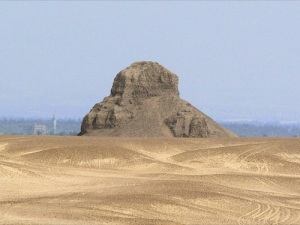
The Black Pyramid of Amenemhet III. The inner core made of mud bricks is exposed. Josephus records that the Israelite slaves were given the task of building the Pyramids. The Pyramids of the 12th dynasty had an inner core that was made of mud bricks.
Egypt’s wealth and power reached it’s peak in the 12th dynasty under Sesostris III and his son Amenemhet III but as they had no successors, the Middle Kingdom started to fall apart when they died. Moses, an Israelite baby, was adopted by the Princess Sobekneferu and groomed to be the next Pharaoh (Amenemhet IV). Amenemhet IV did in fact co-reign with Amenemhet III for a period of 9 yrs but when he had to flee to Midian at the age of 40 years, there was suddenly no successor for Amenemhet III. Amenemhet III’s daughter Sobekneferu had to take over the reigns when Amenemhet III died. She only lived for another 4 yrs and when she died, the 12th dynasty ended, Egypt fell into turmoil and became politically unstable. There was a quick succession of Pharaohs in the 13th dynasty until Neferhotep who was the Pharaoh who was ruling when Moses (Amenemhet IV) returned from exile in Midian. After a series of ten plagues that were inflicted on Egypt, Neferhotep let Moses take the Israelities into the desert. When they did not return, he pursued them with his army. The Israelites were able to cross the red sea at the Gulf of Aqaba but Neferhotep and his army drowned when they tried to follow.
Not only did Egypt lose its slave labour force, it lost it’s monarch, it’s entire army and it’s transportation system. It was a massive defeat and not something that Egyptian historians would want to memorialize.
When the Israelites left Egypt, Pharaoh and his son died and all the Egyptian army drowned in the Red Sea taking all of Egypts chariots with them. Egypt was then thrown into turmoil. Thy Hyksos were able to take power and Egypts second intermediate period followed (until the Hyksos were finally defeated in the 18th dynasty).
The Israelites, therefore, had a profound influence on Egypt having designed the first pyramid (in the third dynasty) and having provided slave labour for various public works which included making mudbricks for the construction of the last of the great pyramids (those of the 12th dynasty). The country was destabilised when Moses (Amenemhet IV) went into exile as there was nobody to continue the 12th dynasty. Egypt suffered massive losses as a result of the Exodus and as a result became vulnerable to invasion. The Hyksos took over and ruled Lower Egypt for the next 400 yrs (the second intermediate period).
Placing Joseph in the 3rd dynasty and Moses in the 12th dynasties not only fits very well with the archaeological evidence, it fits very well with the Biblical account and shows how Majestic God is.
Many scholars now realize that Moses was born during the 12th dynasty when Amenemhet III was pharaoh and the Exodus occurred around 1445bc during the 13th dynasty when Neferhotep was Pharaoh.
There is much archaeological evidence to support this revelation, however, it means that the traditional dates of the 12th and 13th dynasties need to be revised.
http://www.diggingsonline.com/pages/rese/dyns/yusef.htm
When it comes to locating Joseph in the history of Egypt, there are two schools of thought.
The Bible says that the Israelites sojourned in Egypt for 430 years. Exodus 12:40 says “the length of time that the Israelites live in Egypt was 430 years.”
The New Testament also refers to this 430 years. Galations 3:17 says ” The law, introduced 430 years later, does not set aside the covenant previously established by God and thus do away with the promise. “
Because of this many scholars believe that the 430yrs commenced with the promise being given to Abraham 215yrs before Jacob and his family moved to Egypt.
The result of this is that some scholars believe that Joseph came only 215 years before Moses lead the Israelites out of Egypt.
http://www.ancientexodus.com/topics/index/new-york-times-book-review/
http://www.specialtyinterests.net/exodus.html
Other scholars believe that the Joseph was 430 years before the Exodus.
Joseph went to Egypt some 9-10 yrs before Jacob did.
When Jacob and his family went to Egypt, the Israelites numbered about 70. When they left Egypt they numbered around 2 million. They needed time time multipy to this number. Not withstanding this, it is obviously very important to know whether the Isralites were in Egypt for 430 years or 215 years so that we know in which dynasty to look for Joseph.
It is also important to know how the Egyptian dynasties are ordered.
People who believe in a 215 yr sojourn in Egypt look for Joseph earlier in the 12th dynasty and have nominated Mentuhotep as a possibility.
People who believe in a 430yr sojourn in Egypt look for Joseph in an earlier dynasty and given the similarities between Joseph and Imhotep, have tended to place Joseph in the 3rd dynasty.
Placing Joseph in the 3rd dynasty would require an even greater revision of Egyptian history and a complete revision of the Chronology to allow for parallel dynasties running concurrently in the North and the South and also for the common practice of coregency.
This would bring Egyptian history into complete agreement with the Bible.
One of the problems of placing Joseph in the 12th dynasty means that the flood of Noah would most likely have occurred during during one of the earlier dynasties (2450bc) and this is not only out of keeping with the Bible but there is no archaeological evidence of a worldwide flood during any Egyptian dynasty.
The Bible records that Noah had a grandson named Mizraim who seems to be one of the Patriarchs of Egypt. The flood would, therefore, have preceded even the predynastic periods of Egyptian History.
Even Manetho, whom most archaeologist regard as the most authoritative source of information on the chronology of Egyptian history, believed that Mizraim and Menes (the first Pharaoh) were the same person.
Placing Joseph in the 3rd dynasty and Moses in the 12th dynasties not only fits very well with the archaeological evidence, it fits very well with the Biblical account. What we know about these people from the Historical records can then be used to fill in the gaps in the Biblical record revealing how miraculous, amazing and glorious the Hand of God has been in dealing with mankind.

